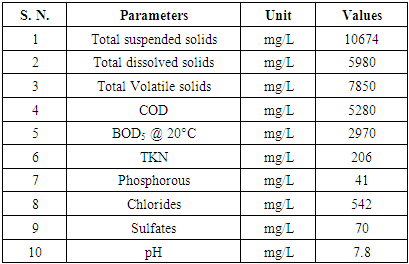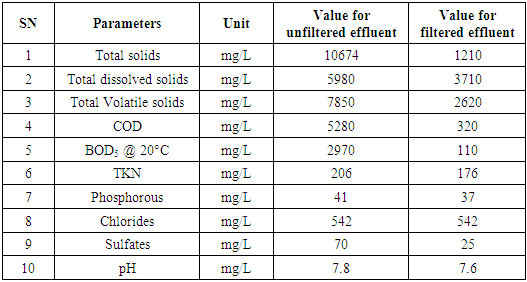-
Paper Information
- Paper Submission
-
Journal Information
- About This Journal
- Editorial Board
- Current Issue
- Archive
- Author Guidelines
- Contact Us
American Journal of Environmental Engineering
p-ISSN: 2166-4633 e-ISSN: 2166-465X
2019; 9(1): 12-15
doi:10.5923/j.ajee.20190901.03

Enhancing Efficiency of Anaerobic Digestion by Sand Filtration of Effluent
1Research Scholar, SSBT’s College of Engineering and Technology, Bambhori, Jalgaon, MS, India
2Professor, Civil Engineering, SSBT’s College of Engineering and Technology, Bambhori, Jalgaon, MS, India
Correspondence to: M. Husain, Professor, Civil Engineering, SSBT’s College of Engineering and Technology, Bambhori, Jalgaon, MS, India.
| Email: |  |
Copyright © 2019 The Author(s). Published by Scientific & Academic Publishing.
This work is licensed under the Creative Commons Attribution International License (CC BY).
http://creativecommons.org/licenses/by/4.0/

The effluent of an anaerobic digester is rich in terms of solid concentration, particularly the suspended solids [1]. It may be rich in terms of nutrients also depending upon the source from where it has been generated. These solids in the effluent are reflected in terms of high COD. The effluent of the anaerobic digester can be used for irrigation purpose or may be discharged into some receiving water-body or on land. It can be further treated also to enhance its recyclability. In each case, it is desirable that the effluent is of high quality or in other words it is having less solid content. The solid content of the effluent can be reduced either by effluent settling or by effluent filtration. The settling of effluent is also a growing technology yet it is in its primitive stage. The present work has experimentally explored the second option that is the effluent filtration. It is found that the effluent can be effectively filtered to reduce the COD and solid content of itself, thus making the disposal easier. The experimental study has been done for the campus of an engineering college, SSBT’s College of Engineering and Technology, Bambhori, Jalgaon, MS.
Keywords: Anaerobic digestion, Effluent filtration, Wastewater recycling
Cite this paper: Parag M. Patil, M. Husain, Enhancing Efficiency of Anaerobic Digestion by Sand Filtration of Effluent, American Journal of Environmental Engineering, Vol. 9 No. 1, 2019, pp. 12-15. doi: 10.5923/j.ajee.20190901.03.
Article Outline
1. Introduction
- Traditionally aerobic treatment of wastewaters has been the preferred option over anaerobic treatment for environmental engineers owing to the speed of treatment basically. The anaerobic biomass has a very poor yield. Hence in effect its speed of decomposition becomes poor. The effective speed of decomposition can be increased by increasing the biomass concentration. Conventionally the biomass is concentrated by settling. However the anaerobic biomass has very poor settling characteristic. Hence filtration of the biomass is considered to be a better option. Here is a review of studies done of sewage filtration by some investigators: Graja and Wilderer [2] investigated soil biotechnology treatment of wastewater and found soluble COD removal efficiencies between 40 and 60% and nitrogen removal efficiencies around 96%. Munch and Barr [3] used controlled struvite crystallization for side stream filtration coming from sludge concentration units in order to remove phosphorus from. A magnesium, ammonium and phosphate crystal occurring naturally was used. Jeison et al [4] investigate the feasibility of filtration of sludge using membrane filtration. They found that the effluent can be effectively filtered and the digester efficiency can be significantly increased. Design of filter needs organic loading rate. Researchers have proposed organic loading rates also. Organic loading rates between 0.976 and 24.4 g/m2 BOD5 per day is used for many facilities [5, 6].Matejcek et al [7] did studies using high strength wastewater also. Their long term studies were based considered the effluents obtained from restaurants. The significant finding in this work is the determination of upper limit for organic loading. The results suggested that the maximum organic loading should be between 7.32 and 11.71 g BOD5 per m2 per day. The rural development committee of Washington State Department of Health in 2002 has done regressive assessment of research on sewage filtration. Nakada et al [8] has studied the filtration of sewage from pharmaceutical industry. Daniel et al [9] studied the filtration of domestic sewage. Liang et al [10] investigated the ultra pressure filtration of domestic sewage. The present work has used sand filtration technique for the filtration of slurry of anaerobic digester digesting kitchen waste. It is observed that the sand filtration can effectively reduce the COD of the digester effluent significantly. It can operate for long run and is viable in size. The case study is done for the residential campus of an engineering college, SSBT’s Colelge of Engineering and Technology, Bambhori, Jalgaon, MS.
2. Experimental Study
- The first part of this study is to design an anaerobic digester using kitchen waste and to obtain effluent. In the next part the effluent of digester has been filtered using a sand filter. The COD of effluent with and without filtration are compared. A small size digester is designed using plastic material. A cylindrical can of size 54 cm diameter and 90 cm height is used as shown in figure 1.
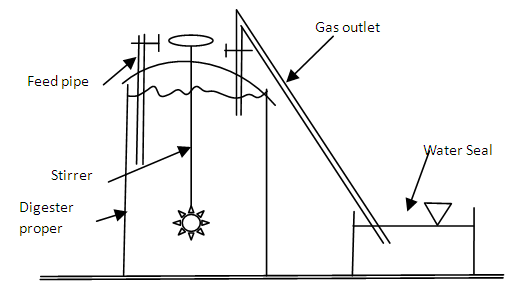 | Figure 1. Experimental set up of an anaerobic digester |
3. Results and Discussion
- The slurry fed to the digester has been characterized for some important parameters as presented in table 1. They are determined using relevant standard methods for characterization of waters and wastewater.
|
 | Figure 2. Effluent COD variation with time |
 | Figure 3. Effluent BOD reduction with time |
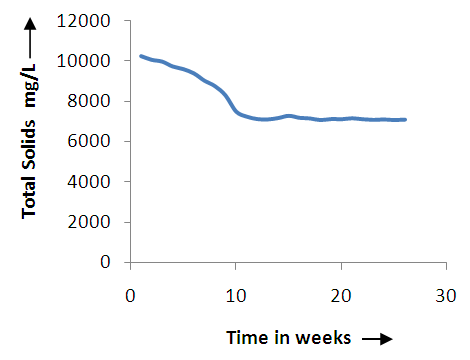 | Figure 4. Variation of total solids in the experimental anaerobic digester with time |
 | Figure 5. Comparison of COD of filtered and unfiltered effluent |
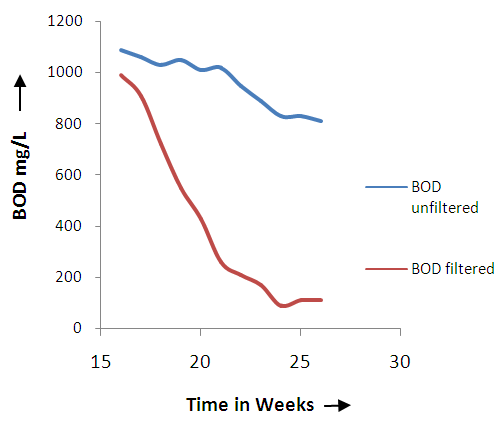 | Figure 6. Comparison of BOD of filtered and unfiltered effluent |
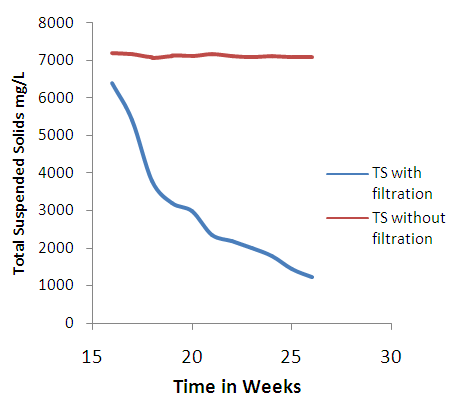 | Figure 7. Effect of filtration on Total Suspended Solids |
|
4. Conclusions
- The anaerobic digestion effluent is rich in terms of BOD, COD and other parameters of concerns. Its disposal is a problem. It cannot be used directly for irrigation purpose. However filtration by sand media is an effective method process of removal of organic content from the effluent. It brings down the COD and TS in effluent effectively and makes it fit for irrigation. The filter has uninterruptedly worked for six months. Hence its endurance can be assured. The filter size is quite small compare to the digester. Hence it can be put in practice. It is hoped that the findings of the present research will provide useful database for the designers of the filters for anaerobic digester effluent.
List of Abbreviates

 Abstract
Abstract Reference
Reference Full-Text PDF
Full-Text PDF Full-text HTML
Full-text HTML